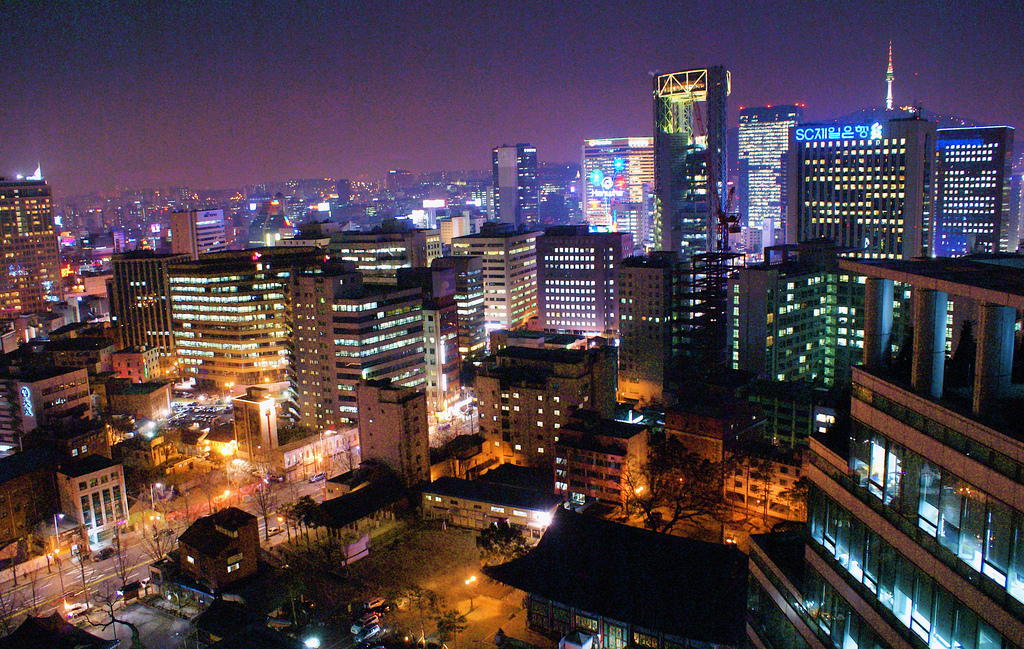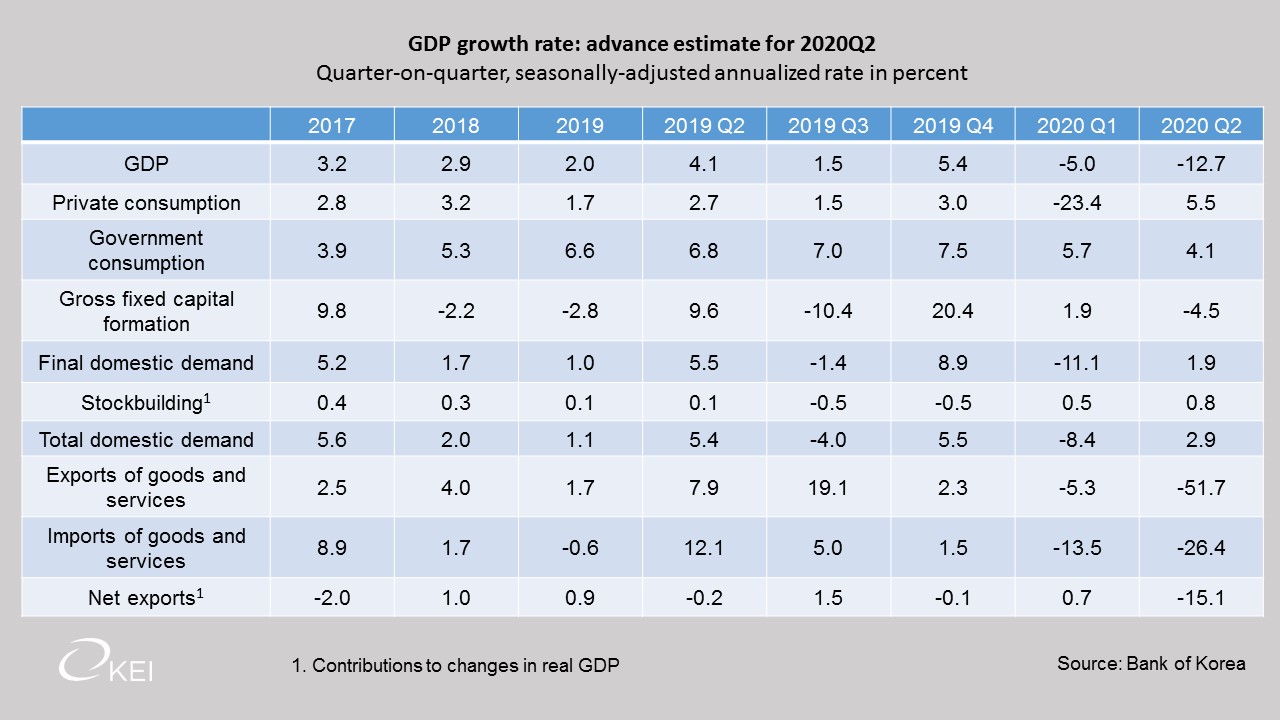The Peninsula
After a Sharp Decline, Korean Economy is Poised to Rebound in the Second Half of 2020

By Randall S. Jones
Following a 5.0 percent decline in the first quarter of 2020, real GDP fell 12.7 percent at a seasonally-adjusted annual rate (saar) in the second quarter (table below), the largest decrease since the Asian financial crisis more than two decades ago. Despite Korea’s success in limiting the spread of the coronavirus and its large-scale fiscal response to boost the economy, it was unable to escape the economic impact of the pandemic and avoid a recession.
Stabilization of domestic demand, while exports collapsed
Private consumption rebounded with growth of 5.5 percent (saar) in 2020Q2, reflecting strong purchases of durable goods. Consumption was supported by the easing of some pandemic-related restrictions on economic activity and the government’s cash payments to households beginning in May. The payments were 1 million won ($833) to households with four or more members. Government consumption also increased in 2020Q2, supported by the first two supplementary budgets. Consequently, final domestic demand increased 2.9 percent, despite a decline in fixed investment that included both construction and facilities investment.
However, exports fell 51.7 percent (saar), led by declines in shipments of cars and petroleum products. With imports falling by only half as much as exports, net exports made a huge negative contribution of 15.1 percentage points to GDP.

On the production side of GDP, the drop in exports had a severe impact on manufacturing output. It fell 31.5 percent (saar) in 2020Q2, even though sales of goods in Korea returned to pre-pandemic levels by May, according to data on credit card transactions. Service-sector output fell 4.3 percent in the April to June period, compared to a 9. 3percent drop in the previous quarter. While the service sector is recovering, credit card payments for services remain about 10 percent below historical norms. As in other countries, the recovery of services lags behind that of goods, reflecting the fear of physical contact during the pandemic.
An economic rebound in the second half of 2020
After the release of the 2020Q2 data, Nam-ki Hong, the Minister of Economy and Finance, said that “It’s possible for us to see a China-style rebound in the third quarter as the pandemic slows and activity in overseas production, schools and hospitals resume”. Chinese GDP jumped 11.5 percent on a quarter-on-quarter basis in 2020Q2 following a 10 percent decline in the first quarter.
Fiscal policy will help support an economic rebound. On July 3rd, the National Assembly passed the third supplementary budget, which amounted to 35.3 trillion won (1.9 percent of GDP), the largest single extra budget ever approved. The government expects to spend around three-quarters of the budget during the third quarter of 2020. Combined with the first and second supplementary budgets (11.7 trillion won and 12.2 trillion won, respectively), extra spending in 2020 amounts to 59 trillion won.
The third supplementary budget focuses on employment growth by extending for three months a program that helps companies keep employees on their payroll by covering 90 percent of the wages of workers on paid leave. Additional funds were allocated to the employment insurance fund, which is overwhelmed with applications for benefits. The government estimates that around 8.9 million workers will benefit from the third supplementary budget, including 3.2 million workers who are at risk of losing their jobs, 1.0 million small business owners and 4.7 million receiving quarantine support.
The Korean New Deal will be supported by 6.3 trillion won of investment from the third supplementary budget. This initiative for 2020-25 is aimed at transforming the economy from a fast follower to a leader, from a carbon-dependent economy to a green economy, while making society more inclusive. The New Deal includes a Digital New Deal (12 projects), Green New Deal (8 projects) and stronger social safety nets (8 projects).
GDP growth for 2020 is projected to be negative
The government is hoping that policies will keep GDP growth positive at 0.1 percent in 2020. However, the Bank of Korea said at its July 16 monetary policy meeting that “GDP growth this year is likely to be lower than the May forecast of minus 0.2 percent.” The next projection by the central bank is expected at the end of August. According to the IMF’s June outlook, Korea’s GDP will fall by 2.1 percent in 2020, though this is a relatively modest decline compared to its forecast of an 8.0 percent contraction in the advanced economies.
With the rapid implementation of the third supplementary budget, the decline in Korea’s GDP in 2020 is likely to be less than 1 percent. For example, taking the OECD’s estimates in June for GDP growth in the third and fourth quarters of this year (9.9 percent and 8.2 percent, respectively at an annualized rate), GDP would decline by around 0.7 percent in 2020. Such an outcome assumes that Korea continues to be successful in coping with the coronavirus. In fact, the number of new cases is limited to around 50 per day. Thus far, Korea has limited the total number of infections to around 14,000 and the number of deaths to around 300, relatively low numbers by international standards.
The wide range of forecasts for Korea in 2020 reflects the great uncertainty about the impact of the pandemic and the risk of a second wave of the coronavirus. Given the importance of exports in the Korean economy, the pace of recovery depends to a large extent on the depth and length of the global recession, which is depressing investment and employment in Korea.
Randall Jones is a Visiting Fellow at Columbia University and a Non-Resident Fellow at the Korea Economic Institute of America. The views expressed here are the author’s alone.
Image from xoxoryan’s photostream on flickr Creative Commons.
